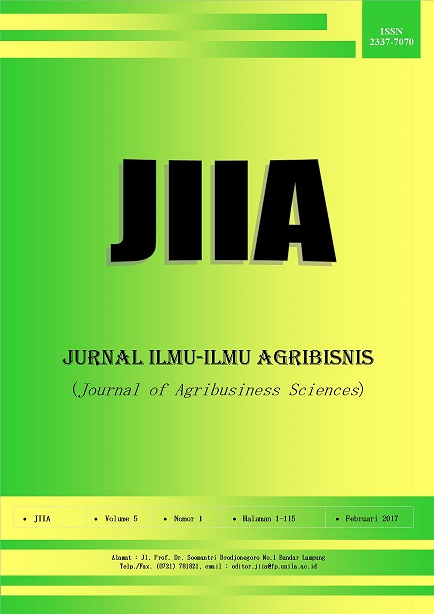ANALISIS FINANSIAL DAN STRATEGI PENGEMBANGAN USAHATANI JAMUR TIRAM PUTIH DI DESA PAMPANGAN KECAMATAN SEKINCAU KABUPATEN LAMPUNG BARAT
DOI:
https://doi.org/10.23960/jiia.v5i1.1672 Abstract View: 791
Abstract View: 791
Abstract
This study aims to analyze financial viability of oyster mushroom farming and to arrange strategies of developing oyster mushroom farming. This research is located in Sekincau District of West Lampung which is intentionally chosen with the consideration that it has good prospects in the field of horticulture, especially the oyster mushroom. Respondents include three farmers cultivating oyster mushrooms. The research was conducted in February 2016. The first objective is analyzed quantitatively by using financial analysis (Net B / C, NPV, IRR, and Payback Period) with a compounding factor (CF) of 9 percent and the second goal is analyzed descriptively with SWOT analysis. The results showed that the oyster mushroom farming in West Lampung was feasible and profitable to be pursued. Financially, the business is still viable because the NPV and Net B / C is higher than 1, and the value of IRR is higher than the interest rate. Strategy priority to develop oyster mushroom farming consists of improving the quality of oyster mushroom products in order to attain physical and non physical assistance from government, widening marketing networks, and improving the use of appropriate technology in farming.
Key words : development strategiy, financial analysis, and oyster mushroomDownloads
Downloads
Published
How to Cite
Issue
Section
License
Authors who publish with this journal agree to the following terms:
Authors retain copyright and grant the journal right of first publication with the work simultaneously licensed under a Creative Commons Attribution License that allows others to share the work with an acknowledgement of the work's authorship and initial publication in this journal.
Authors are able to enter into separate, additional contractual arrangements for the non-exclusive distribution of the journal's published version of the work (e.g., post it to an institutional repository or publish it in a book), with an acknowledgement of its initial publication in this journal.
Authors are permitted and encouraged to post their work online (e.g., in institutional repositories or on their website) prior to and during the submission process, as it can lead to productive exchanges, as well as earlier and greater citation of published work (See The Effect of Open Access).














